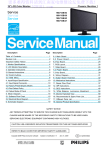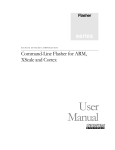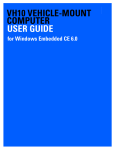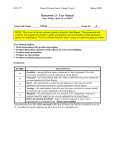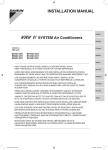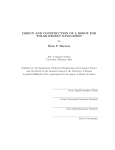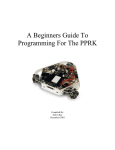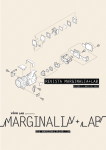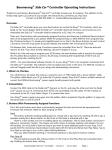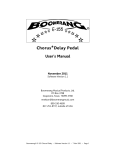Download Autonomous UAV Final Report - Senior Design
Transcript
AUTONOMOUS UAV FINAL REPORT Client Senior Design Team 10 Date Submitted: April 27, 2011 Space Systems & Controls Laboratory (SSCL) Faculty Advisor Matthew Nelson Team Members Anders Nelson (EE) Kshira Nadarajan (CprE) Mathew Wymore (CprE) Mazdee Masud (EE) 0|Page Table of Contents List of Figures List of Tables List of Symbols List of Definitions 3 3 4 4 1. Introductory Material 1.1 Executive Summary 1.2 Acknowledgement 1.3 Problem Statement 1.3.1 General Problem Statement 1.3.2 General Solution Approach 1.4 Operating Environment 1.5 Intended Users and Uses 1.5.1 Intended Users 1.5.2 Intended Uses 1.6 Assumptions and Limitations 1.6.1 Updated Assumptions List 1.6.2 Updated Limitations List 1.7 Expected End Product and Other Deliverables 2. Approach and Product Design Results 2.1 Approach Used 2.1.1 Design Objectives 2.1.2 Functional Requirements 2.1.3 Design Constraints 2.1.4 Technical Approach Considerations and Results 2.1.5 Testing Approach Considerations 2.2 Detailed Design 2.2.1 Software System 2.2.2 Control System – Controllers 2.2.3 Sensor System 2.2.4 Power System 3. Resources and Schedules 3.1 Resources Requirements 3.1.1 Personnel Effort Requirements 3.1.2 Other Resource Requirements 3.1.3 Financial Requirements 3.2 Schedules 3.2.1 Project Schedule 4. Implementation 4.1 Hardware Implementation 4.1.1 Gumstix Implementation 4.1.2 PIC Implementation 4.1.3 PCB Implemention 4.2 Software Implementation 4.2.1 Obstacle Detection Module 4.3 Power System 5. Testing 5.1 Hardware Testing 5.1.1 Gumstix Testing 5 5 5 5 5 6 7 7 7 7 7 7 8 8 9 9 9 9 9 10 10 10 10 12 20 21 23 23 23 24 24 25 25 27 27 27 28 29 30 30 36 38 38 38 1|Page 5.1.2 PIC Testing 5.2 Sensors Testing 5.2.1 Laser Range Finder Testing 5.2.2 Sonar Testing 5.3 Power Testing 5.3.1 Endurance Test 6. Future Work 6.1 Current Status 6.2 Future Implementations 7. Lessons Learned 7.1 Importance of Communication 7.2 Full Team from Start 7.3 Attention to Detail 7.4 Too Much in Too Little Time 8. Closure Material 8.1 Project Team Information 8.1.1 Client Information 8.1.2 Faculty Advisor Information 8.1.3 Student Team Information 8.2 Closing Summary 8.3 References 8.4 Appendices 8.4.1 Appendix I – Competition Rules 8.4.2 Appendix II – Gumstix AngelStrike Change Log 8.4.3 AppendixIII – Gumstix User Manual 8.4.4 Appendix IV – PICstix Communication Protocol 38 39 39 40 40 40 42 42 42 43 43 43 43 44 45 45 45 45 45 46 47 48 48 50 53 55 2|Page List of Figures Figure 1.3.2 a) System Block Diagram Figure 2.2.1 a) Software Flow Diagram Figure 2.2.2 a) Main Control Board – Initial Design Figure 2.2.2 b) Option 1: System-On-Chip Figure 2.2.2 c) Option 2: All in one MCU Figure 2.2.2 d) Option 3: Divide and Conquer MCUs Figure 2.2.2 e) Draft System Design with Gumstix Figure 2.2.2 f) Controller Design Figure 3.2.1 a) Project Schedule Figure 4.1.3 a) PCB Schematic Figure 4.2.1 a) Overall System Level Software Block Diagram Figure 4.2.1 b) Visualization of range scanning Figure 4.2.1 c) Laser Range Scanning Resolution and Area Coverage Figure 4.2.1 d) Urg Viewer Tool and its Visual Output Figure 4.3 a) Image of LiPo Battery Figure 4.3 b) Power System Block Diagram Figure 5.1.2 a) Sonar Range Testing List of Tables Table 2.2.2 a) Hardware Options Scoring Table 3.1.1 a) Documentation Expected Labor Table 3.1.1 b) Design Expected Labor Table 3.1.1 c) Implementation Expected Labor Table 3.1.1 d) Labor Totals Table 3.1.2 a) Components Estimate Table 3.1.3 a) Financial Summary Table 5.2.1 a) Testing Results for Laser Range Finder Obstacle Detection Module 3|Page List of Symbols C – capacity of a battery kg – kilograms (unit of mass) LiPo – Lithium Polymer, a type of battery mAh – milli-Ampere hours (unit of electric charge) V – Volts (unit of electromotive force) List of Definitions 466 team – a team of mechanical and aerospace engineers responsible for creating the quadrotor platform API – Application Programming Interface GPS – Global Positioning System IARC – International Aerial Robotics Competition IMU – Inertial Measurement Unit JAUS – Joint Architecture for Unmanned Systems MCU – Microcontroller Unit RC – Radio Control RF – Radio Frequency SSCL – Space Systems and Control Laboratory at Iowa State University TI – Texas Instruments, an electronic components manufacturer UAV – Unmanned Aerial Vehicle 4|Page 1. Introductory Material 1.1 Executive Summary The team will be working on developing the electronics on an autonomous unmanned aerial vehicle (UAV) for use in the International Aerial Robotics Competition. This competition involves using the vehicle to penetrate and navigate an office environment to complete tasks outlined in the competition rules. Our team will be working with the Space Systems and Control Lab (SSCL) of Iowa State University as well as two multidisciplinary senior design teams from other departments. The other two teams will be in charge of developing the platform on which to put the control electronics, and designing the controls including navigation algorithm and vision system. The SSCL will act as an advising element to the senior design teams and will be providing the funding for the development of the project. While designing the electronics of the platform, we conducted research into past competitions and competitors, and we considered several possible solutions. In this document we will be describing the decisions we made in choosing the optimal solution for the various problems and its subsequent implementation. Our design consists of five main modules that will be described later in this document. The general outline is that the UAV will use sensors such as a laser range finder and an inertial measurement unit (IMU) to collect the data to be used by the microcontroller system to be used in the stability and flight control. In addition to these sensors, we will also include a communication system to communicate sensor and control data to a base station that will process the computation-intensive navigation and decision-making algorithms. 1.2 Acknowledgement We would like to acknowledge our advisor, Matthew Nelson of the SSCL, for technical advice and oversight. In addition, Koray Celik, a PhD student in the SSCL, was a major advisor for our team. His experience in aerial robotics was a unparalleled source of experience all the teams on this project would have been lost without. We would also like to acknowledge the Engineering 466 and 467 teams for their help, patience, and efforts on this project. 1.3 Problem Statement 1.3.1 General Problem Statement The International Aerial Robotics Competition states in its mission that the main motivation behind this competition is to promote and push the research and implementation of efficient indoor navigation systems, flight control and autonomy in aerial robots. The problem is that the UAV must be 5|Page capable of flying autonomously, i.e., without any real time human control, within an indoor environment without the aid of GPS navigation techniques. The robot will also be expected to complete a basic set of tasks, such as identifying and replacing a USB drive (as in previous competitions). These tasks must be completed within ten minutes. The robot must weigh no more than 1.5kg. Our specific challenge within the scope of the senior design project is that we have to design and build the on-board electronics and power systems for a platform that will fly autonomously and implement obstacle avoidance and stability control. 1.3.2 General Solution Approach Our solution to this problem is to build a platform that will be able to make most of the important decisions required for sensor support, communication, and power management on board. It will send information such as the range finder and image/video data through a wireless link to a remote base station where the heavy computations such as localization and search algorithms will be implemented. A control system shall be developed by the Engr466, Controls team, which the base station will be able to wirelessly command the robot to move according to the instructions based on an API developed for this purpose. This API will allow implementation of important mapping and search algorithms to enable complete autonomy. The robot will be tested in a controlled environment where the behavior can be observed and improved. It is to be noted that our platform will only enable the implementation of localization algorithms and serve as a functional platform but not implement it. The following is the general system block diagram that indicates the components that we propose to implement. Figure 1.3.2 a) System Block Diagram 6|Page 1.4 Operating Environment The operating environment will be based on the competition set up which imitates the interior of an office. The environment will be completely indoors as the main objective of the competition is to achieve efficient indoor navigation. There will not be external factors such as wind or rain since it will be completely indoors. The robot will also have to navigate without the use of a GPS system. The missions is intended to be a stealthy one so there shall be no human beings inside the actual office setting where the robot has to operate. 1.5 Intended Users and Uses 1.5.1 Intended Users The system will be used by the SSCL team for the IARC competition. 1.5.2 Intended Uses The system will have a specific purpose of doing the mission outlined in the competition, i.e. getting inside the secured compound and retrieving the flash drive. However, the scope for this senior design team is to design the electronics platform to be capable of expansion, without implementation of the systems that will make it autonomous, mainly, the object recognition and mapping systems of the base station. 1.6 Assumptions and Limitations 1.6.1 Updated Assumptions List 1) The platform delivered to us by the 467 team will be capable of stable flight. 2) No additional money apart from that provided from the SSCL will be required. 3) No major change in the competition mission will take place. 4) This project will be picked up by another team after this year to expand it to the full autonomy required for the competition. 5) The parts and components that we have agreed upon shall integrate into the system without any major compatibility issues. 6) The resolution of the inertial unit and other sensors will allow for adequate accuracy in implementation of complex obstacle avoidance algorithms. 7|Page 1.6.2 Updated Limitations List 1) The delivered platform will not be able to perform object recognition, but it will enable future addition of an object recognition system. 2) The robot will not be able to bear any additional weight other than the on-board components. 3) The robot will not be able to hover or stay powered beyond a time period of 12 minutes if the need for such a situation arises. 4) There will be a single robot platform developed and there will be no backup structure. 5) After the first semester, major changes in the platform itself will not be easily possible. 6) The team has limited time for implementation due to other course studies. 1.7 Expected End Product and Other Deliverables The deliverable for this project is electronics for a quadcopter that is capable of stable flight, obstacle avoidance and remote termination in case of emergency. The platform will also be easily expandable to enable autonomous navigation. The steps taken to ensure ease of expansion have been indicated in our design decisions, choice of sensors and the overall physical structure of the platform. For example, the processor has USB host capabilities to allow for the use of devices such as laser range detectors and portable camera and vision sensors. The chassis also has been designed to accommodate the weight and volume of the laser range finder. This platform will hold power for at least 12 minutes while operating in an indoor environment. The electronics will be able to interact and take in data as required by the system. The robot will be able to communicate with a base station which will receive sensor data and send back navigation commands. A complete documentation manual along with the detailed API specifications will be provided to the client for ease of control through the base station. The API will specify functions required for the base station to command the robot to take necessary decisions through a wireless RF communication link. 8|Page 2. Approach and Product Design Results 2.1 Approach Used 2.1.1 Design Objectives Design the onboard electronics and power systems for an autonomous unmanned aerial vehicle capable of competing in the IARC Design the basic onboard software for the abovementioned UAV Design systems that can be integrated with the vehicle platform designed by the Platform team Design systems that can be expanded as part of a competition-worthy UAV by a separate team 2.1.2 Functional Requirements Lightweight o Entire platform under 1.5kg Low power o Battery powered o 10 minutes minimum flight time (12 minute goal) Four brushless motors at 11V Electronics systems Operational o Able to handle onboard stability control o Wireless base station communication Wireless link capable of at least 42 meters Expandable o Potential for navigation in a GPS-denied environment Connectivity for laser range finder Considerations for computer vision system o Potential for executing remote autonomous commands o Connectivity for manual remote kill switch o Connectivity for wire-burn USB stick drop-off system 2.1.3 Design Constraints Compatibility o Must integrate into Platform team‘s vehicle platform o Must potentially fulfill competition requirements Time o Deliverables due in May 2011 o Team has other time-consuming obligations Experience 9|Page o Team has limited design experience o Team has limited implementation experience Cost o Budget is supplied by SSCL o Budget is not definite but definitely limited 2.1.4 Technical Approach Considerations and Results The design of the systems of the platform will be simulated and analyzed. The results of each simulation will determine the designs and specs that will be considered. The considered design will be approved and then it will be implemented to get the prototype. The prototype will be tested further and follow the testing approaches. Upon passing all the testing the final platform will be delivered. 2.1.5 Testing Approach Considerations The testing will contain several different approaches. They are the following: Communication – This test is on the communication between the platform and the remote base station. The distance and the speed of communication will be tested. Integration – This test is to determine the proper connections have been made and communication between components is fully functioning. Obstacle avoidance- This is the test on the sensors. The reliability and the accuracy of obstacle avoidance will be tested from the movements of the platform in various directions. Endurance (Power) - this is the battery testing. The battery will be run under expected load and voltage over time will be monitored during testing 2.2 Detailed Design 2.2.1 Software System The software system consists of modules that run of different controllers but work in unison to provide the end user a friendly API. Currently the software system consists of the following modules: 1. Positioning System: This system serves as the part of the navigation block that will be used for single waypoint navigation. This will be implemented on the base station controller. The positioning module will eventually require an implemented Simultaneous Localization and Mapping Algorithm, but our end deliverable will only issue basic commands directing the robot to move in a given direction for a given distance or speed. The current position and the desired 10 | P a g e final position are not determined through mapping, the platform will provide an API to such an algorithm that will now be able call our functions as long as it provides key information parameters like speed and direction of motion. 2. Heading: This module will be implemented on the main on- board controller on the robot. It acquires information from the positioning system and sends commands to the motor controller. 3. Motion Controller: This is the module which controls the motors to achieve the desired speed/motion. The feedback about the percentage thrust achieved from this module is also sent to the heading module. 4. Dynamic Stability Control Module: This module uses the data from the internal sensor consisting of the inertial unit to maintain stability of the robot. It is also possible to integrate information from external sensors like range detection units such as the IR to combine the stability control and the obstacle avoidance, but we wanted to modularize our design to minimize interdependence. 5. Obstacle avoidance module: This module reads the current sensor data and identifies if there is any obstacle to avoid. If there is, the system is sent back to the motion control state where the motion parameters are re-calculated based on odometry information. If there is no obstacle, then the system returns to positioning with a ―Final Met‖ feedback. Here is a graphical view of the software block diagram consisting of all the modules mentioned above. 11 | P a g e Figure 2.2.1 a) Software Flow Diagram 2.2.2 Control System – Controllers The control system is the brains of the autonomous UAV. The control system has three main functions: It uses sensor data to provide flight via the motor controllers. It provides a platform for executing autonomous actions needed for the competition. It communicates with the base station, accepting command decisions and providing data useful in making those decisions. In addition, the control system supports manual flight via a hobbyist RC control system, the implementation of a remote manual kill switch. Figure 1.3.2a is a block diagram of the initial high-level system designed to provide that functionality. 12 | P a g e Note that the initial expected inputs of the on-board microcontroller were an IMU and a sensor array, including sonar and a laser rangefinder. The expected output of the microcontroller was to the four motor controllers of a quadcopter, and a wireless communications unit was expected to provide communication with the remote processing, as well as kill switch and JAUS functionality. The camera and vision system was expected to exist separately. Using these I/O requirements, the following general design for a main control board was created. Note that the camera was now being considered as a direct input into the microcontroller unit. In later iterations, the camera system was again made a separate component, as it was considered out of the scope of this project. Also, a camera system is expected to require dedicated communication channels due to the high bandwidth and processing power required for transferring and working with video. Figure 2.2.2 a) Main Control Board - Initial Design At this point, the issue was raised that, in general, small microcontrollers do not have the USB host capabilities that would be needed for a USB laser rangefinder. The team was reluctant to exclude the possibility of a laser rangefinder for use in navigation and mapping by future teams, and the project advisor agreed. While small laser rangefinders using the RS-232 communications interface do exist, the team found that such lasers are more expensive models, selling for approximately $1000 more than the USB model the team had found. In the interest of budget and expandability, the team decided to require the system to support a USB laser rangefinder. 13 | P a g e This decision became crucial to the microcontroller system design. System-on-chip/computer-onmodule options were now considered, with the other option being a smaller microcontroller with USB host capabilities, such as the TI Stellaris. At this point, the following three high-level system options were proposed. Figure 2.2.2 b) Option 1: System-on-chip 14 | P a g e Option 1 featured a system-on-chip module that could run Linux connected to a smaller microcontroller that would handle flight stability calculations and the output to the motor controllers. This option was initially thought to be overly large and power-hungry for the project. Figure 2.2.2 c) Option 2: All in one MCU Option 2 consisted of a single 32-bit microcontroller with USB host capabilities, such as a TI Stellaris, with a separate communication unit such as an XBee. Although the smallest and most power15 | P a g e efficient of the three options, this option was considered too rigid, with little room to expand an alreadybusy microcontroller. Figure 2.2.2 d) Option 3: Divide and Conquer MCUs Option 3 was considered to be more favorable with the addition of a separate, smaller microcontroller for flight stability and a 32-bit USB-host-capable MCU for sensor input and 16 | P a g e communications with the RF unit. This option would provide the advantage of sandboxing the flight stability, allowing the UAV to stay aloft even if the main controller should fail. Also, the flight control unit could be programmed and then left alone, aside from minor performance tweaks, which would be a major usability boost for a future group implementing autonomous functionality with no knowledge of the flight control details. While the team was initially in favor of Option 3, the project advisor encouraged further research into system-on-chip options. Part of the reasoning behind this decision was that a controller running Linux would already have USB drivers, hugely simplifying I/O programming. Further research indicated that many other elements, including wireless communications, power, programming, implementation and general expandability and usability would be simplified with a system-on-chip device running Linux. Additionally, the power budget indicated that the power required by the electronics, even a system-on-chip, would be minor compared to the power used by the motors. The weight budget showed considerable room for play as well, so those factors, while still important, were of less concern than initially thought. Thus, the following table comparing and scoring main controller options was produced. All options considered included USB host capability and a WiFi module. Table 2.2.2 a) Hardware Options Scoring Options were scored based on size and weight, power consumption, price and other features for usability and expandability. The highest score was given to a system from a company named CompuLab. However, upon contact, the company declined to sell single products to academia. Thus, the Gumstix Overo Fire, in a system similar to Option 1, became the highest-scoring option. 17 | P a g e Meanwhile, a 16-bit PIC MCU from Microchip‘s PIC24 series was chosen as the flight controller. Since many companies offer similar MCUs, a PIC was chosen because of the SSCL‘s history of work with PICs, allowing the team to tap into existing equipment resources and an experienced knowledge base. The selected PIC fits its purpose well. It features nanoWatt XLP low-power technology and a wide variety of I/O options, including 25 remappable I/O pins which will allow the team to accommodate for any sensors which may be connected to the flight controller for basic obstacle detection. Additionally, the PIC supports the major serial I/O options for interfacing with the main controller and the IMU, as well as five PWM channels for the motor controllers. And the PIC has five input capture lines, which can be used for processing signals from a hobbyist RC receiver for manual flight control. The final iteration of the control system high-level design is shown below. New additions include the RC receiver and a heartbeat signal between the flight controller and the main controller. This heartbeat will allow the two controllers to track each other‘s presence and take appropriate measures should either fail. 18 | P a g e Figure 2.2.2 e) Draft System Design with Gumstix As proof-of-concept, the team‘s research has showed that previous IARC competitors have used similar systems. The team has arrived at the proposed design independently, so the similarity with other competitors‘ systems is encouraging. Also, the project advisor, who has previous experience in this type of design, has approved the choices made. Finally, the selected components were thoroughly researched in order to ensure they met the requirements and were compatible. A more detailed design followed and is shown below. This may be considered the proposed control system design. Note the inclusion of the Gumstix Summit board, and expansion board for the Gumstix Overo Fire computer-on-module that features USB connections and an unpopulated 40-pin header that can be used for other sensor expansions. The Summit also includes a DVI-D connection that can be used in conjunction with the Fire‘s Bluetooth module for system programming and testing. 19 | P a g e Figure 2.2.2 f) Controller Design 2.2.3 Sensor System The sensor system is composed of two types of sensors: internal sensors that measure the characteristics of the platform, and external sensors that take measurements of the environment around the platform. The internal sensors category is composed of the inertial measurement unit (IMU). The IMUs looked at for this project were those with a minimum of 6 degrees of freedom. This means that the IMU allows measurement of acceleration along each of the axis and measurement of rotation about the axis in 3 dimensions. These work as feedback for stable flight control. The IMU that was selected is a 9 degree of freedom IMU from Analog devices called ADIS16400. This IMU has temperature calibration on the device and a very high degree of sensitivity. In addition, speaking with Koray Celik, a PhD student in the SSCL with extensive aerial robotics experience recommended this IMU very highly for our use. This option serves the project well. 20 | P a g e The external sensors needed for this project would be a laser range finder for use in navigation, 2 cameras for navigation and object recognition, and sonar for altitude measurements. The range finder and cameras were originally eliminated from our project scope since navigation algorithms and object recognition are to be implemented by later teams. However, at the start of the second semester, a new Engr 466 team was added to our project. They became the Controls team for the project and thus were able to add input into what sensors were needed for the project. From their input and Koray‘s suggestions, it was decided to go with the Hoguyo URG-04LX Laser range finder, Logitech C905A webcams, and MaxSonar EZ4 with serial interface. The Hoguyo URG-04LX range finder was selected for its large field of view and the capability to interface with either USB or RS232 interfacing. The field of view is a sweep of 240 degrees with a 4 meter range. This large area sweep is necessary for a robust navigation algorithm and easy collision avoidance. The webcams were a recommendation from Koray. From his past experience using vision systems on RC helicopter navigation, the Logitech C905A webcams are light, have high resolution, and can auto-adjust through circuitry on the camera. The EZ4 sonar was selected due to its output through a serial connection. This eliminates the need to do analog to digital conversion and also send a ping to the sonar that many systems require. This part lowers the complexity of the connection that much further and saves time in programming. 2.2.4 Power System The power system is the main source of operating all the equipment in the autonomous UAV. The main focus is using a LiPo (Lithium Polymer Battery). This battery will be used for three reasons: High charge/discharge efficiency Lightweight Adaptability to a wide variety of packaging shapes and ruggedness The power system will be powering the On-Board Micro-controller, the motors of the quad copter, the IMU, the Sensors and the camera. The block diagram in figure 1.3.2a shows a view of what the power system connects to. The LiPo battery that is considered ideal is a 3-cell pack with 11.1V voltage, 6500mAh capacity, and 20C maximum for the continuous current output. There are three main battery options for the quadcopter. These options were: Single Pack In this pack the ideal battery that is considered will be in the form of one single pack. It can be found off the shelf or it can be ordered with the required specifications. The single pack 21 | P a g e will consist of 3 cells packed together. Since, this is a huge pack with everything together the amount of space needed to fit it will be larger. Series Pack This is one form of combination pack to meet the requirement of the ideal package. Here, three separate single cell packs, or 2 cells and 1 single-cell pack will be combined. This will be done by combination of the different packs to make it a 3 cell pack with 11.1V combined from each of them. The 6500mAh capacity will be same for all the separate packs with the 20 C maximum continuous current. This form of packaging will help putting the three cells separately by accommodating them in suitable space on the platform. Parallel Pack This is another form of combination pack that has the similar specifications as the serial packaging. Also, it will have all the advantages as the serial packaging. In this form of packaging, 3 single cells will be combined again to form a 3 cell package. Again, 3 single cell packs, or 2 cell and 1 cell pack will be combined. Every single cell will have the same voltage i.e. 11.1 V, but the capacity of them will be different and it will be combined to get 6500 mAh, with a 20C maximum continuous current. From these options, the parallel pack was the best option. Taking a recommendation from Koray, it was decided to wait until the platform was completed before batteries were selected. As such, we would be able to measure the exact current draw of the system and so choose exactly the capacity that would be needed to provide the flight time that is desired. 22 | P a g e 3. Resources and Schedules 3.1 Resources Requirements 3.1.1 Personnel Effort Requirements The requirements in labor that will be used for this project can be broken into 3 main sections. The sections of labor are in Documentation, Design, and Implementation. These sections can each be further divided into subtasks that must be accomplished for the overall project. The tables below list out how the tasks were estimated to be split between members of the senior design team as well as the totals for each section of labor. Table 3.1.1 a) Documentation Expected Labor Documentation Expected Labor Team Member Project Plan Plan Presentation Design Document Design Presentation Final Documentation Total Anders Nelson 10 10 15 10 15 60 Mazdee Masud 10 10 15 10 15 60 Mathew Wymore 10 10 15 10 15 60 Kshira Nadarajan 10 10 15 10 15 60 Total 40 40 60 40 60 240 Table 3.1.1 b) Design Expected Labor Design Expected Labor Team Member Past Competitor Research Parts Research&Selection Sensors System Power System Control System Software System Total Anders Nelson 10 10 15 10 5 0 50 Mazdee Masud 10 10 10 15 5 0 50 Mathew Wymore 10 10 5 0 20 5 50 Kshira Nadarajan 10 10 5 0 5 20 50 Total 40 40 35 25 35 25 200 Implementation Expected Labor Table 3.1.1 c) Implementation Expected Team Member Control System On-Board Programming Sensor Integration Power System Communication System Parts&Integration Testing Final System Testing Anders Nelson 20 10 15 10 5 40 60 Mazdee Masud 20 10 10 15 5 40 60 Mathew Wymore 15 30 5 0 10 40 60 Kshira Nadarajan 15 30 5 0 10 40 60 Total 70 80 35 25 30 160 240 Labor Totals Table 3.1.1 d) Labor Totals Team Member Documentation Design Implementation Anders Nelson 60 50 160 Mazdee Masud 60 50 160 Mathew Wymore 60 50 160 Kshira Nadarajan 60 50 160 Total 240 200 640 Total 270 270 270 270 1080 23 | P a g e Total 160 160 160 160 640 3.1.2 Other Resource Requirements This section includes the items needed for implementing our project. These are the electronic components for the platform. This list does not include those items used for implementing the platform that was done by the Platform team. Some items included are those that were intended to be bought, but were recommended against buying so as to concentrate on other aspects of implementation. Table 3.1.2 a) Components Estimate 3.1.3 Financial Requirements The following is the summary of the financial requirements for this project. This is based on a labor cost estimate of $20 per hour. Table 3.1.3 a) Financial Summary This total is without the cost of the platform designed by the Engr 467 Platform Team or the future items that may be needed to develop this project further. 24 | P a g e 3.2 Schedules 3.2.1 Project Schedule Figure 3.2.1 a) Project Schedule 25 | P a g e On this schedule it is important to make note that this is the original schedule for the setup from the first semester. After the new team came on board second semester, different priorities were changed. For example, basic maneuvering and flight stability became part of the new Engr 466 Controls team. Thus, it is no longer a viable part of our schedule. Even removing such items, our schedule slipped much during the second semester. The first several weeks were spent bring the new team up to speed, defining roles of the teams, reevaluating decisions, and so on. Some of these items causing the change in the original schedule plan are included in the implementation section below. 26 | P a g e 4. Implementation 4.1 Hardware Implementation 4.1.1 Gumstix Implementation The Gumstix module is composed of a Gumstix Overo Fire computer-on-module unit and a Gumstix Summit expansion board. These components have been received, assembled and successfully booted. The default Gumstix rootfs and Angstrom Linux kernel have been modified, rebuilt and redeployed to the Gumstix nonvolatile memory. The modified kernel includes user-space SPI support through the spidev protocol driver, as well as a stable version of gcc for native compilation on the Gumstix. The Gumstix has also been configured to automatically set up an ad-hoc WiFi network on bootup, complete with a DHCP server that allows for easy connection from a development machine. All changes made to the Gumstix kernel and configuration have been documented and included in Appendix II and III. Additionally, the physical connections required for testing the SPI connection from the Gumstix to the PIC and the RS-232 connection from the laser rangefinder to the Gumstix have been soldered to the appropriate through-hole pins on the Summit expansion board. A communications protocol designed for the SPI connection between the Gumstix and the PIC, dubbed the PICstix protocol, has been designed and is included in Appendix IV. SPI communication between the Gumstix and the PIC is still under development. Such low-level communication between a Linux kernel and an embedded microcontroller is proving to be difficult to implement. On the Gumstix, the connection is implemented in software using the spidev protocol driver, which is included in the Gumstix kernel and available once SPI is enabled. The unimplemented items for the Gumstix include the direct interrupt request line to the PIC, the connection from the cameras to the Gumstix and the implementation of the PICstix communications protocol. The implementation of these items was omitted due to complications with higher-priority items, such as reliable SPI data transfer between the PIC and the Gumstix. Early in the implementation process, the Gumstix was discovered to be a temperamental device. While it works well enough once it is set up correctly, setting it up can be difficult, and much of its 27 | P a g e documentation is written by users with considerable amounts of experience with such systems. Issues encountered included: Failure to boot with factory-installed image Difficulty connecting to Iowa State‘s WiFi to download packages Failure to set up a stable gcc installation with the Gumstix‘s package manager The need to rebuild the kernel to support SPI The overlooking of the non-standard 1.8V logic level on the GPIO pins All of these issues have since been resolved. 4.1.2 PIC Implementation The final choice for the microcontroller to be used in the system is a PIC32MX795F512L. This PIC has been received in the form of a plug-in module (PIM) that can be used with the Explorer 16 development board. A PicTail daughter board is used with the Explorer 16 to bring out the pins necessary for the PIC‘s SPI, PWM and sonar connections. A custom PCB is expected to eventually replace the Explorer 16 and daughter board. The connection to and parsing of data from the MaxBotix LV-MaxSonar EZ4 sonar module, used to determine altitude, has been successfully implemented. This includes a data connection to the receive input for one of the PIC‘s UART modules, as well as a connection from the sonar to ground and power. The sonar module sends serial data in the form of an ASCII ‗R‘ character, three ASCII numerical digits forming an integer representing the range in inches, up to 255, and a carriage return. The UART module is programmed to trigger an interrupt when its receive buffer is half full. The PIC‘s UART receive buffer has 8 entries, so this means the interrupt will fire when the UART has received at least 4 entries. If the data can be parsed according to the above-described format, a global altitude variable is updated with the new data. This variable will eventually be used in the altitude control loop. For testing, this variable has been outputted in binary to the eight LEDs of the Explorer 16 board. Pulse-Width Modulation (PWM) outputs have also been successfully programmed. These signals will eventually be used to execute flight commands with the Gaui flight controller. The outputs of the PIC have been set up to be programmable with a duty cycle ranging from 1ms to 2ms, which is 0 to 100% of the recognized range of the Gaui. Adjustments in duty cycle can be made in steps as small as 0.2% of this range. 28 | P a g e The unimplemented items for the PIC currently include the input from the IMU, the direct interrupt request line from the Gumstix, the implementation of the PICstix communication protocol, the input from the RC receiver and the programming of the flight control loops. The failure to meet these implementation goals stems from two main reasons. The first major issue that delayed PIC development was that the PIC was upgraded from a PIC24 to a PIC32 approximately two-thirds of the way through the semester. This design change was made based on the recommendation of a project leader more experienced with aerial robotics systems. From an engineering standpoint, the upgrade provided significant performance increase, especially for floatingpoint calculations, allowing more flexibility in the control loop programming. Additionally, the upgrade had nearly negligible changes on the power, cost and weight budget. At the time, the upgrade was not expected to slow development much, but in retrospect, it did slow development considerably. The second issue plaguing PIC development was the voltage difference with the Gumstix, which caused many items to be ignored in the last weeks in an attempt to obtain reliable communications between the two controllers the system is based around. 4.1.3 PCB Implementation A part of the circuitry needed for the overall system is to be implemented on a custom PCB. On the PCB is the IMU, PIC, connections for sonar input, RC controller, motor control out, Gumstix to Laser conversion, among others. The schematic for the system that utilizes the smallest items possible to achieve the task was created and is given in 4.1.3a. The layout of the PCB is to implemented at a later time. If any changes in connection is needed at a later date, through hole connections will be added with connection to the PIC. 29 | P a g e Figure 4.1.3 a) PCB Schematic 4.2 Software Implementation 4.2.1 Obstacle Detection Module The controls team members working on the path planning algorithm were the key users of the obstacle detection module. This can be seen clearly in the software block diagram (Fig 4.2.1a). Our implementation of the obstacle detection module is explained in the following sections. 1) Laser Range finder hardware For the hardware we picked the Hokuyo URG-04LX model which is widely used in robotic applications. The range detection specifications are given below: Voltage 5.0V +/-5% Current 0.5A (Rush current 0.8A) Detection Range 0.02m to approximately 4m Laser wavelength 785 nm, Class 1 30 | P a g e Scan angle 240° Scan time 100msec/scan (10.0Hz) Resolution 1mm Angular Resolution 0.36° Interface USB 2.0, RS232 Weight 5.0 oz (141 gm) 2) Laser Range finder Gumstix Interface The interface preferred was the serial communication link because this would minimize the power consumption on the Gumstix and also reserve the USB host for other sensors like cameras. Since the URG works at 5V and the Gumstix IO pins read at 1.8V, some additional circuitry was to be added later to adjust the communication channel. A circuit was built using the Sipex 232acp chip was used to pull down the voltage and enable communication at the TTL level, but since this chip was designed for pulling down the voltage to a range of 2V – 4 V, the communication with the Gumstix serial pins were not possible. A PCB design has been created in which this issue is addressed. For testing the software, the Urg was just connected on plug and play mode with a laptop computer running 32-bit Linux. 3) Obstacle Detection Software The algorithm for obstacle detection module is described in the following section Algorithm: 1) For each <angle, range > pair, a. Calculate the absolute distance relative to the center(refer to Fig 1.2) Distance = cos (90-angle)*range b. If(distance < 2m && distance >1m) probabilityOfObstacle = (2-distance)/1 //Since the probability that it is an obstacle is weighted based on how close it is. c. If(distance > 2m) //Not considered an obstacle probabilityOfObstacle = 0.0 31 | P a g e d. If(distance < 12m) //Surely an obstacle probabilityOfObstacle = 1.0 e. cumulativePrediction = cumulativePrediction*k/m + ((m-k)/m)*probabilityOfObstacle This step is based on the Impulse Response filter of the form ps,a = ps,a ps,a-1 𝑚 ps,a- + 𝑚−𝑘 1 𝑚 pa, : smoothed value of prediction of obstacle at angle t : pa, new : m 𝑘 smoothed value in the previous angle instant raw observation obtained at angle instant : number of <angles,range >pair readings used to compute the running average k : the parameter used to vary the effect of pa, new has on the smoothed value. Return the probabilityOfObstacle. 2) The above step is repeated for ranges of angles for the Left, Right and Front side. The ranges for these sections can be modified. For example, if the robot needs to move left without moving forward, the angle range can be adjusted to 60º to 120 º. For the front it can be between -45º to +45º etc. One of the objectives while implementing this algorithm was to allow these flexibilities based on the needs of the platform and the mapping algorithm‘s requirements. 3) This For each of these ―sides‖ if the probability returned was > 0.6, it is considered as an obstacle. This threshold can be adjusted based on the sensitivity of the motors. 4) This process is repeated over a time period that can be adjusted again, based on the sensitivity of the motor and the needs of the control mechanism. Refer to figures Fig 4.2.1b and Fig 4.2.1c for a visual sense of how the calculation is done. 32 | P a g e 33 | P a g e Fig 4.2.1a) Overall System level Software Block Diagram—including obstacle detection module Green: Implemented by us Yellow: Implemented by other teams Uncolored: Unimplemented 0º -120º Fig 4.2.1b) Visualization of range scanning and extraction of absolute distance information +120 Fig 4.2.1c) Laser range scanning resolution and area coverage information Source: Acroname Robotics. Retrieved on 4/23/2011 from http://www.acroname.com/robotics/info/arti cles/laser/laser.html#e4 34 | P a g e 4) Interface with other modules The obstacle detection module was designed exactly to the specification of the navigation module implemented by the controls team. The algorithm implemented by them is a ―Follow the left wall‖ algorithms. The mission of the robot in the competition is to detect a USB drive and replace it with a decoy; a searching task. During the large group meetings, this was discussed and chosen based on different considerations. We worked closely with the other team for this and their algorithm required a discrete input: Is there an obstacle on the left? On the right? In the front? This was based on a certain minimum distance that could be adjusted but is currently estimated at 1.8m because the platform spans close to a meter and a clearance of 400 cm on either side was kept in mind. This estimate can be further adjusted based on the sensitivity of the motor and the platform‘s motion behavior. The obstacle detection module therefore is designed to give these outputs as required by the inputs of the navigation algorithm. More on the navigation team‘s algorithms can be found in the manual of the Controls team‘s report. 5) Urg Ctrl Library and Urg Viewer The Urg community online is very active and there is excellent documentation available online at http://www.acroname.com/robotics/info/articles/laser/laser.html . The urg-viewer is a graphical toll kit which can be used to visually perceive the current readings of the laser range finder. It is basically a capture of the range and bearing information projected in real time as the laser range finder is moved and is scanning. This can be used as both a de-bugging tool at the remote base-station and also to study the behavior and noise patterns of the sensor. Refer to Fig 4.2.1d for a snapshot of what this looks like: 35 | P a g e Fig 4.2.1 d) Urg Viewer Tool and its visual output 4.3 Power System The power system is the main source of operating all the equipment in the autonomous UAV. The main focus is using a LiPo (Lithium Polymer Battery). This battery will be used for three reasons: High charge/discharge efficiency Lightweight Adaptability to a wide variety of packaging shapes and ruggedness The power system will be powering the On-Board Micro-controller, the motors of the quad copter, the IMU, the Sensors and the camera. The block diagram in figure 4.3b shows a view of what the power system connects to. The LiPo battery that we are using is two 3-cell packs with 11.1V voltage, 3200mAh capacity, and 20C maximum for the continuous current output. The batteries will be connected in 3s2p, to get 6400mAH capacity. The system we are getting for the battery is Parallel Pack This is a form of combination pack that has the similar specifications as the serial packaging. Also, it will have all the advantages as the serial packaging. In this form of packaging, 3 single cells will be combined again to form a 3 cell package. Again, 3 single cell packs, or 2 cell and 1 cell pack will be combined. Every single cell will have the same voltage i.e. 11.1 V, but the capacity of them will be different and it will be combined to get 6400mAh, with a 20C maximum continuous current. 36 | P a g e Figure 4.3 a) Image of LiPo Battery BEC Voltage Regulator A voltage regulator will be used to for the power system. This voltage regulator will produce 11.1V to the ESC‘s and to the motors, 3.3V to the PIC, and 5V to Laser, Sonar, GumStix, Camera, IMU. The setup is like a simple circuit, the fig is given below: Motor Motor Motor Motor ESC‘s Laser 11.1 V Gumstix Current Measure 11.1 V Lipo Battery 3-cell Voltage Regulator 5V Camera Sonar 3.3 V IMU PIC Figure 4.3ba) Power System Block Diagram 37 | P a g e 5. Testing 5.1 Hardware Testing 5.1.1 Gumstix Testing The Gumstix‘s ad-hoc WiFi network has been tested through extensive normal use. Throughout the implementation process, the WiFi connection has been constantly used for configuring and testing other aspects of the Gumstix. Not once has the connection been unexplainably dropped or found to be non-responsive. Thus, the stability of the connection has been tested and found to be satisfactory. However, constant use has also shown that establishing the connection to the Gumstix can sometimes require several attempts. This is believed to be an issue that occurs only shortly after the Gumstix has been booted. Allowing the Gumstix to run for around a minute before attempting to connect to it reliably yields a successful connection. The SPI connection between the PIC and the Gumstix has been tested using a readily-available spidev test program, an oscilloscope, the register watch function of the MPLAB IDE used to program the PIC, and the console output of the Gumstix. Thus far, the both the PIC and the Gumstix have been shown to be receiving data from each other. However, the PIC is not processing the data correctly, and the data between the PIC and the Gumstix is not being accurately transferred. At best, the Gumstix has been shown to correctly receive a repetitive bit pattern from the PIC. These issues are still being worked on by the current team. 5.1.2 PIC Testing The pulse-width modulation output component of the PIC has been tested with an oscilloscope to ensure that the outputs are of the expected duty cycle and the waveforms are clean and stable. These tests have been successful. PWM outputs have not been tested with the Gaui, as the PIC has not yet been integrated with the flight platform. The MaxSonar EZ4 sonar module has been tested by displaying the received range value on the Explorer 16‘s LED bank. Using a yardstick to measure actual ranges to a variety of surfaces, the sonar module has been shown to be generally accurate within an inch between the range of 8 and 44 inches. All ranges under 8 inches are reported as 6 inches. Test results are reported in the diagram below. 38 | P a g e Please see the Gumstix testing section for details on testing the SPI connection from the PIC to the Gumstix. 5.2 Sensors Testing 5.2.1 Laser Range Finder Testing In the initial plan as per our design document submitted last semester, the obstacle detection module was to be tested on the autonomous system by introducing obstacles at different sides and comparing the output of the module (0/1) with the desired answer (obstacle present/ not present – a binary value that can be encoded as 1 and 0 respectively.) Since the platform itself is not being controlled by the pic or gumstix yet, the test plan shifted a little bit from our original plan. The test was run without running the module on a flying platform. Although it is very likely that the vibrations on the platform due to flight and the noise in motion might introduce more errors in the algorithm, the goal was to first test this on a stationary system. 39 | P a g e The following table demonstrates the results of the test. Number of trials in each unit: 15 Side True Positives (%) True Negatives (%) False Positives(%) False Negatives(%) Left 100 0 14.28 85.71 Right Front Average 100 98.4 99.46 0 1.6 0.5 35.71 28.571 26.19 64.28 71.42 73.81 Table 5.2.1 a) Testing Results for Laser Range Finder Obstacle Detection Module The following is an example of the output on the console when there was an obstacle on the left hand side of the sensor: ======================================= Closest obstacle detected at distance = 0 mm and at angle 90.000000 Is left blocked?? 1.000000 Is right blocked?? 1.000000 Is front blocked?? 1.000000 5.2.2 Sonar Testing Please see 5.1.2 paragraph 2 for sonar testing results as this is included in the PIC testing. 5.3 Power Testing 5.3.1 Endurance Test The LiPo battery has some set of characteristics. When the battery is new, the output is not to the optimum level. After few cycles of charging the battery, the battery starts producing the output according to our desired level. During this lifetime of the battery it starts to lose its capacity, and after more cycle of charges the output continues going down. The plan for now is to have two sets of battery. One set for testing the flight of the platform, other one is only for the competition. The competition set will be used and charged few cycles to get the maximum output for the competition. After the Platform team completed the platform near the end of the year, it was possible to do a test on power draw of the motors while flying. Using a simple RC controller, batteries with known charge capacity were used to fly the quadcopter for as long as it could. Using two 3cell LiPo 3200mAh batteries, 40 | P a g e with the platform weight at 1278g, the platform was able to fly for 20min 52 sec. The platform weight was slightly less than the possible amount of the competition, but this gives a good estimate for us to use on the motor power draw. It can be concluded that 2 standard 3200mAh LiPo batteries will be a sufficient investment for achieving the desired flight time with room for error. 41 | P a g e 6. Future Work 6.1 Current Status Here at the end of the semester, there is still much work to be done on this project. We have managed to set the foundation for future teams to pick up where we left off and continue towards the overall end goal. Currently, the parts implemented are: Parts selected and overall design setup Custom PCB has been designed Gumstix o Ad Hoc Network automatically sets up o Connections wired for PIC and RS-232 to Laser o Communication protocol with PIC created PIC o Receives sonar data in o PWM output established with simple functions created Laser Range Finder o Data communication established o Call functions created for ease of use o Obstacle detection algorithms created o Viewer for data available for user Power System o Voltage regulation circuit designed o Batteries to be ordered selected 6.2 Future Implementations Determine final layout of PCB o Order PCB Gumstix o Setup frame grabber for cameras o Setup communication protocol with base station o Implement software for control of all system o Send data to base station through software PIC o Make connection with IMU o Implement control algorithms o Test stability of control and find drift o Test interchange between RC and PIC to Gaui Implement the navigation and vision algorithms Test and debug entire system 42 | P a g e 7. Lessons Learned 7.1 Importance of Communication This senior design project was extensive. There were 3 senior design teams all working on this one project. Finding the correct level of communication was very difficult. Although staying in touch with what the other teams were doing, sometimes the detail at which it was discussed proved to be detrimental to the accomplishing of the work. For example, at the start of the second semester, new people were added to the project in the form of a new Engr 466 team, later the Controls team, and the PhD student, Koray, mentioned previously in this report. With the new people came new ideas. We spent the first few weeks going over the design decisions of the past semester, and fielding the different thoughts and visions that came up. In the end, only the PIC version changed with all the rest remaining the same. However, this took much time that could have been spent actual implementation. Just like too much, too little can also be a bad thing. Differing visions of the system and styles of implementation can lead to the ―But I thought…‖ sentence started that means something went wrong in communications. For our team, communication was a large problem, both too much and too little. With so many people all working on different yet related things, communication had to be good to make it all work out as planned. We learned that communication was the most important part of our project. Unfortunately, we were not able to improve until it was too late to slow the loss of time. 7.2 Full Team from Start As mentioned in the previous section, we gained team members in the middle of the year. At this point, we lost valuable time defining the roles of the teams and catching the new ones up on the system we spend the past semester designing. What would have been best would have been to have the full team at the start. That way it would have been easier to say exactly who did what and know the thoughts of the full team on a solution before starting the actual design process. We lost time when the newer members of the team joined. 7.3 Attention to Detail As much as we would like it to be so, components don‘t always work the way we want or expect them to. For example, the little detail of voltages. The Gumstix takes in a voltage of 5V. However, it only outputs logic at 1.8V. This small detail created problems for us when we looked at a communication channel between it and the PIC. The PIC at 3.3V did not see the small voltages. So, this adds another 43 | P a g e circuit to be included on the custom PCB. In turn, it means not being able to order the PCB when you may want. Little details in a large project can slow it down. 7.4 Too Much in Too Little Time This project was more complex than most of the other projects in senior design. It required working with a large team, working out a bunch of details and doing things we had never worked with before. We have learned a great deal through this project, but we still have much we would have liked to be able to do. But, we set ourselves up to do more than we had time to do. It reaches appoint in which we had to select, with the help of our advisor, what the most important items were to have for future teams. Although we didn‘t complete all we planned to do, we learned how to prioritize to the things we could do. 44 | P a g e 8. Closure Material 8.1 Project Team Information 8.1.1 Client Information The client for this project is the Space systems and Controls Lab. This is a multi-disciplinary lab in the aerospace department at Iowa State University which runs multiple projects such as High Altitude Balloon Experiments in Technology, (CySAT) Cyclone SATellite cubesat project, and the Mars Analog Vehicle for Robotic Inspection & Construction. The Director of the Lab is Matthew Nelson and he is also the Advisor for our team. The contact information for the client is: Space Systems and Controls Lab 2362 Howe Hall Ames, IA 50011-2271 [email protected] 515-294-2640 8.1.2 Faculty Advisor Information Our faculty advisor is Matthew Nelson, the Director of the Space Systems and Controls Lab. His contact information is: Chief Design & Operations Engineer Department of Aerospace Engineering Space Systems & Controls Laboratory 2271 Howe Hall, Room 2331 Iowa State University Ames, IA 50011-2271 Office: (515) 294-2640 Fax: (515) 294-3262 [email protected] 8.1.3 Student Team Information The ECpE 491 Senior Design Team website is located at http://seniord.ece.iastate.edu/may1110/. This site will be updated as the school year continues. The team members are: 45 | P a g e Mazdee Masud Iowa State University Electrical Engineering 131 N. Hyland Avenue #14 Ames, IA-50014 319-431-5804 [email protected] Mathew Wymore Iowa State University Computer Engineering 1019 Delware Avenue #17 Ames, IA 50014 641-295-5522 [email protected] Anders Nelson Iowa State University Electrical Engineering 504 ½ Lynn Avenue Ames, IA 50014 515-447-8359 [email protected] Kshira Nadarajan Iowa State University Computer Engineering Ames, IA [email protected] 8.2 Closing Summary The IARC is an exciting, challenging and educational opportunity for its participants. Prize money aside, Iowa State University and the SSCL stand to gain good reputation if their team fields a competition-worthy vehicle. This project is an integral part of such a vehicle. The proposed design has been carefully crafted to meet the requirements set forth by the competition rules, as well as the constraints imposed by the physical platform. Furthermore, the design has been created with expandability and usability in mind. Although we were not able to create a full competition worthier vehicle, the ground work that has been laid is done with the hope of future teams completing the project. We have learned valuable lessons through the design and implementation of this project. It was an eye opening experience about the true nature of engineering within the limitations of the real world. 46 | P a g e 8.3 References International Aerial Robotics Competition (IARC) Site. Association for Unmanned Vehicle Systems International (AUVSI). Web. Retrieved 10 October, 2010. <http://iarc.angel-strike.com/> Overo Fire COM Product Page. Gumstix Corp. Web. Retrieved 2 December 2010. <http://www.gumstix.com/store/catalog/product_info.php?products_id=227> Summit Expansion Board Product Page. Gumstix Corp. Web. Retrieved 2 December 2010. <http://www.gumstix.com/store/catalog/product_info.php?products_id=215> Powerizer High Power Polymer Battery Product Page. BatterySpace.com. Web. Retrieved 2 December 2010. <http://www.batteryspace.com/Powerizer-High-Power-Polymer-Battery-11.1v-3300mAh36.63Wh-40A-rate.aspx> ADIS16405: High Precision IMU Product Page. Analog Devices Inc. Web. Retrieved 2 December 2010. <http://www.analog.com/en/mems/imu/adis16405/products/product.html#ppa_print_table> 47 | P a g e 8.4 Appendices 8.4.1 Appendix I – Competition Rules The following is an excerpt of the rules from the International Aerial Robotics Competition (IARC) Mission 6 outline. Mission 6 is the current mission, being held in August 2011. ―General Rules Governing Entries 1. Vehicles must be unmanned and autonomous. They must compete based on their ability to sense the semi-structured environment of the Competition Arena. They may be intelligent or pre-programmed, but they must not be flown by a remote human operator. Any number of air vehicles may be deployed so long as the gross aggregate weight of each air vehicle does not exceed 1.50 kg. 2. Computational power need not be carried by the air vehicle. Computers operating from standard commercial power may be set up outside the Competition arena boundary and uni- or bi-directional data may be transmitted to/from the vehicles in the arena however there shall be no human intervention with any ground-based systems necessary for autonomous operation (computers, navigation equipment, links, antennas, etc.). 3. Data links will be by means of radio frequencies in any legal band for the location of the arena. 4. The air vehicle(s) must be free-flying, autonomous, and have no entangling encumbrances such as tethers. The air vehicle(s) can be of any type. During flight, the maximum dimension of the air vehicle can not exceed one (1) meter. The maximum takeoff weight of the vehicle cannot exceed 1.50 kg. The vehicle must be powered by means of an electric motor using a battery, capacitor, or fuel cell as a source of energy. The vehicle must be equipped with a method of manually-activated remote override of the primary propulsion system. 5. A maximum of two (2) non-line-of-sight (NLOS) navigation aids may be used external to the designated flight area. It will be assumed that these navigation aids were positioned by a mother ship around the building (but not on top) prior to a aerial robotic sub vehicle launch. The navigation aids must be portable, and must be removed once the team leaves the competition area. GPS is not allowed as a navigation aid. 6. The aerial robotic system is required to be able to send vehicle status and navigation solutions to the Judge‘s remote JAUS-compliant data terminal via the JAUS protocol. This will be done according to the JAUS Standard Set which will be provided to all official teams. Imagery may be delivered to a separate team-supplied terminal using JAUS protocols but other signal formats will also be acceptable. Similarly, kill switch transmissions may use JAUS protocols, but can be achieved by other means without penalty. If more than one aerial robot is deployed simultaneously, intercommunication between the aerial robots may be by any means and any protocol desired. 7. Upon entering the arena under autonomous control, aerial robots must remain within the bounds of the arena or the attempt will end. Vehicles leaving the arena or in the Judges‘ opinion, are about the leave the arena, will have their flight terminated by a Judge. Flight termination actuation will be controlled by a Judge, not the team. Each team will supply the designated Judge with its manually-actuated kill device as they enter the arena prior to their attempt(s), and must demonstrate that the kill switch is functional for the Judge. Either separate kill switches can be provided for each vehicle in multiple vehicle swarms, or a single kill switch that disables all vehicles in the swarm simultaneously is deemed acceptable. 8. The ground station equipment other than the optional navigation aids, manual kill switch mechanisms, and Judges‘ JAUS-compliant terminal interface must be portable such that it can be setup and removed from the arena quickly. A suggestion would be to setup the equipment 48 | P a g e on a roll-cart similar to that shown in Figure 1. Figure 1. Roll-Cart. Operations Teams will be given four (4) flight attempts. The team with the highest static judging score will be given one (1) additional attempt. Each team will be given 15 minutes to setup their system and adjust parameters. If the team is unable to launch an aerial robot within the 15 minute window, the attempt is forfeited. Each team is granted one (1) pass. Once a set of attempts has been completed by a given team, the entire team will be required to leave the arena. No hardware may be left in place. During the static display of the vehicle(s), the vehicle(s) will be measured to verify the 1 meter maximum dimension constraint. The vehicle(s), in takeoff configuration will be weighed to verify the 1.50 kg maximum weight restriction. The vehicle(s) will also be examined to assure that all kill switch functions are fully operational prior to flight. Competition Area The competition flight area (arena) will be constructed within an area that is approximately 30 m long by 15 m wide, and 2.5 m high. This area will be divided into a number of rooms and corridors with various obstacles of various heights. The launch location will be fixed at a distance of 3m and oriented toward a 1 x 1 meter (minimum) opening into a corridor. Navigation aids, if used, may be located anywhere in a 3 meter perimeter bounding the outside of the arena (see Figure 2). A list of typical materials and construction notes (which may be updated from time to time) is provided at http://iarc.angel-strike.com/IARC_Arena_Construction.pdf so that teams can construct similar practice arenas for use in refining their aerial robotic systems prior to arrival on the Competition day. Figure 2. Arena dimensions and notional internal layout 49 | P a g e 8.4.2 Appendix II – Gumstix AngelStrike Change Log WiFi (gumstix.net) To set up an ad-hoc network on bootup, edit the Gumstix's /etc/network/interfaces to include the following lines: allow-hotplug wlan0 auto wlan0 iface wlan0 inet static address 192.168.2.2 netmask 255.255.255.0 wireless-mode ad-hoc wireless-essid gumstix-network Set up a DHCP server on the Gumstix to make connecting to it easier. To do this, create /etc/udhcpd.conf with the contents: start 192.168.2.3 end 192.168.2.254 interface wlan0 max_leases 64 Use this command to run the DHCP server: udhcpd /etc/udhcpd.conf (sdmay11-10) Finally, set the DHCP server to run on bootup by adding the following lines to /etc/rcS.d/S40networking: (after echo -n "Configuring network interfaces... " ifup -a echo "done.") echo -n "Starting DHCP server..." udhcpd /etc/udhcpd.conf echo "done." Creating and deploying a new build The Gumstix kernel and rootfs source can be downloaded, modified and rebuilt using OpenEmbedded. Instructions for obtaining the Gumstix source can be found at http://gumstix.org/access-source-code.html. To deploy a new build, you will need a bootable microSD card. Instructions for creating one can be found at http://gumstix.org/create-a-bootable-microsd-card.html. A bootable microSD should also be included with the AngelStrike project materials. The images for the new build need to be copied to the microSD card. Instructions for doing this are included on the page for creating a bootable microSD card. 50 | P a g e Finally, you can flash the images on the microSD card into the Gumstix's nonvolatile memory using a script, as described at http://gumstix.org/how-to/70-writing-images-to-flash.html. gcc You can try using opkg to install gcc with: opkg install task-native-sdk However, this method has been found to be unreliable. A better method is to include gcc in the rootfs build. Assuming you have OpenEmbedded set up on your system, you can do this by editing: /org.openembedded.dev/recipes/images/omap3-console-image.bb Add this line in the tools section: task-native-sdk / Then rebuild the image using: bitbake omap3-console-image SPI To enable spidev for use in connecting with the PIC, you need to disable the SPI devices built into the kernel by default. This section assumes you have OpenEmbedded set up on your system. Please note that version numbers may change. The devices can be disabled by editing the board-overo.c file. First, navigate to the file. cd ~/overo-oe/tmp/work/overo-angstrom-linux-gnueabi/linux-omap3-2.6.36-r97 cd git/arch/arm/mach-omap2/ Make a copy, just in case. cp board-overo.c board-overo.c-orig And edit board-overo.c. A copy of the edited version of board-overo.c has been included with the AngelStrike project materials. Then from /linux-omap3-2.6.36-r97 make a patch file: git diff –no-prefix git/arch/arm/mach-omap2/board-overo.c-orig \ git/arch/arm/machomap2/board-overo.c > my-board-overo.patch Now edit the bitable recipe to use the patch. Open: ~/overo-oe/org.openembedded.dev/recipes/linux/linux-omap3_2.6.36.bb In the SRC_URI declaration, add the line: file://my-board-overo.patch \ 51 | P a g e Then rebuild the kernel and rootfs: bitbake -c clean virtual/kernel; bitbake virtual/kernel bitbake omap3-console-image Finally, deploy the new build. Other Gumstix resources: http://www.jumpnowtek.com/ http://old.nabble.com/Gumstix-f22543.html 52 | P a g e 8.4.3 Appendix III - Gumstix User Manual Connecting to the Gumstix via console session See the documentation at http://gumstix.org/connect-to-my-gumstix-system.html. Connecting to the Gumstix via WiFi Plug in the Gumstix and give it time to boot. If it was properly shutdown last time, it should set up an adhoc network called "gumstix-network." Use your computer's wireless utility to connect to this network. You should be automatically assigned an IP similar to 192.168.2.3 with a subnet mask of 255.255.255.0. If not, try setting your IP manually. Once the WiFi connection is established, use ssh to connect to the Gumstix: ssh [email protected] If you get a warning about adding an RSA key to the list of known hosts, type "yes." If you get a warning about the host key conflicting with the current known key, that is probably due to a reinstallation of the Gumstix kernel. The previous known key for the Gumstix should be able to be removed using the command: ssh-keygen -R overo.local Once you are connected to the Gumstix, you will find that there is currently no password. To get back to your local machine, use: exit To get a file from the Gumstix to your local machine, use: scp [email protected]:<file-path> <destination-path> Using the Gumstix To edit a text file when you're logged into the Gumstix, use vi <file-path> If you are unfamiliar with vi, it is a text editor that runs within the shell. It does not support mouse clicks. Press "i" to enter insert mode so you can edit the file. To exit insert mode, press escape. Commands are entered preceded by a colon. Type ":w" to save or ":q" to quit. Use ":q!" to quit and discard unsaved changes. Since vi does not echo changes immediately, developers may wish to edit source files on their development machine and use scp to transfer them to the Gumstix. You can use gcc to natively compile programs on the Gumstix. Gcc was included in the latest version of the rootfs flashed to the Gumstix. The documentation for gcc can be found on the Internet or entering "man gcc" into the terminal of the development machine. Note: The Gumstix kernel does not include manual pages, so the "man" command will not work from within a Gumstix session. 53 | P a g e Finally, when you're finished with the Gumstix, always shut it down properly! Connect to the Gumstix and enter: shutdown now Wait at least five seconds, then you can safely unplug the power from the Gumstix board. NOTE: The PICstix protocol has not yet been implemented and is provided as a resource and suggestion for future teams. 54 | P a g e 8.4.4 Appendix IV - PICstix Communications Protocol Overview The PICstix Communications Protocol, in the scope of our project, is used to define the serial communications between the Gumstix single-board computer and the 32-bit PIC microcontroller. The PIC is used for reading in IMU data and sonar data and outputting PWM signals used to drive motor controllers. The PIC can switch between autonomous and manual flight control modes. The Gumstix is responsible for assembling the data gathered from the environment and making macro control choices, i.e., move forward x distance. The Gumstix also uses a laser range finder to monitor obstacle proximity. The Gumstix can quickly halt platform movement via an interrupt request signal to the PIC. That signal is not part of the serial communications but will be discussed at the end of this document. Details The PICstix protocol is designed for 32-bit word communication between the two controllers. Each 32-bit word will be referred to as an instruction. Instructions use little endian format. The Gumstix is the host and the PIC is the slave device. Instructions come in two categories, host instructions (from the Gumstix to the PIC) and device instructions (from the PIC to the Gumstix). Instructions of both types use a 5-bit opcode, defined as the least significant bits of the instruction. The leading four bits are left at 0. In general, the remaining 23 bits are used to carry data. Lead Zeros 31 30 29 28 Data [27...5] Opcode 43210 Some of the data is sent in a signed fixed-point number format, with one sign bit, 12 bits for the whole part and 10 bits for the fractional part. signed fixed => 13bits.10bits Ex. 3.75 => 000000000011.110000000 The idea here is to eliminate the need for floating point data to be sent between host and device. Data with a whole part larger than 512 or a fractional part smaller than 0.1 is not expected, but clearly supported. Host Instructions All of the following instructions are sent from the Gumstix to the PIC. Flight Control – These instructions cause the PIC to adjust motor speeds and make the platform move. Horizontal Motion Opcodes: Forward – 01000 Backward – 01001 Strafe right – 01110 Strafe left – 01111 Lead Distance (signed fixed, cm) Opcode 55 | P a g e 31 30 29 28 [27...15].[14...5] 43210 Distance (signed fixed, cm) [27...15].[14...5] Opcode 43210 Distance (signed fixed, deg) [27...15].[14...5] Opcode 43210 Vertical Motion Opcodes: Up – 01010 Down – 01011 Lead 31 30 29 28 Rotational Motion Opcodes: Turn right – 01100 Turn left – 01101 Lead 31 30 29 28 Data Request – These instructions cause the PIC to send a response with the requested data. The data field is empty for these instructions. Data Request Opcodes: Altitude – 00100 Roll – 00101 Pitch – 00110 Yaw – 00111 0 [31...5] Opcode 43210 Mode Switch – This instruction requests that the PIC change operating mode as designated. Mode Switch Opcode – 00010 Mode Designation Codes: Autonomous – 0x00000F Manual – 0x0000F0 Lead 31 30 29 28 Mode Designation [27...5] Opcode 43210 Main Control – This instruction is used to alter the PIC run state as designated. Main Control Opcode – 00001 Run State Codes: Normal Operation – 0x00000F Simulate Self-Destruct – 0x0000F0 Shutdown – 0x000F00 Reset – 0x00F000 Lead Run State Designation Opcode 56 | P a g e 31 30 29 28 [27...5] 43210 NOTE: Host opcodes 0011 and 0000, as well as all opcodes with a leading 1, are currently reserved. Device Instructions All of the following instructions are sent from the PIC to the Gumstix. Data Response – These instructions are sent as responses to the Gumstix’s requests for data from the PIC. Data Response Opcodes: Altitude – 00100 Lead 31 30 29 28 Distance (signed fixed, cm) [27...15].[14...5] Opcode 43210 Distance (signed fixed, deg) [27...15].[14...5] Opcode 43210 Roll – 00101 Pitch – 00110 Yaw – 00111 Lead 31 30 29 28 Acknowledge/Update – These instructions are sent to the Gumstix to confirm that a command has been received or to report on the execution of a command. The data format for acknowledge/update instructions is composed of two parts, the command being acknowledged or updated and a unique integer, called the command ID. When the PIC receives an instruction, it decodes the command contained in the instruction and assigns a command ID to the command, beginning with 0 and incrementing with each command, up to 262,143. The next command ID after the maximum is 0. Data request instructions are not assigned command IDs. The PIC then sends the command ID back to the Gumstix in the acknowledge instruction. The same command ID is used when the PIC sends an update instruction to the Gumstix. The basic acknowledge/update format is 18 bits for the command ID, 5 bits for the opcode of the host instruction being acknowledged or updated, referred to as the command type, and 5 bits for the opcode of the ackowledge/update instruction. Lead 31 30 29 28 Command ID [27...10] Type 98765 Opcode 43210 Acknowledge/Update Opcodes: Command Received – 01000 Command Update – 01001 Command Executed – 01010 57 | P a g e Error Executing Command – 01111 Autonomous Mode Acknowledged – 00010 Manual Mode Acknowledged – 00011 Normal Operation Acknowledged – 00001 Self-Destruct Acknowledged – 00100 Reset Acknowledged – 00101 Shutdown Acknowledged – 00000 NOTE: Device opcodes 0110, 0111 and 1011, as well as all opcodes with a leading 1, are currently reserved. 58 | P a g e




























































